The Best New York Style Pizza Dough and 14 Tips for Success!!
I’ve been making a lot of this NY style pizza dough recipe …. The obsession started a while back, and I’ve finally found a recipe that I love the best! After years of experiments (and I mean years!), I am now using this recipe based on recommendations from the many fine pizza makers at www.pizzamaking.com and the late great Dough Doctor, Tom Lehmann.

Making Pizza Dough at Home
Making NY style pizza dough is definitely somewhat of an art form. There are so many variables that can be changed aside from the ingredients alone. For example, these variables include:
- oven temperature
- temperature of the water used to make the dough
- proofing methods (room temp vs cold rise)
- order of adding the ingredients (yes, this makes a big difference!)
- mixing time
- use of autolyse
- use of poolish (I don’t do this or the one before, although I have in the past)
And then of course, the toppings which can be simple or as complex as you’d like. But don’t worry too much about all of this – my method is easy and straightforward. Plus, you will make better dough than 99% of the pizza chains out there. You will not want take out anymore!
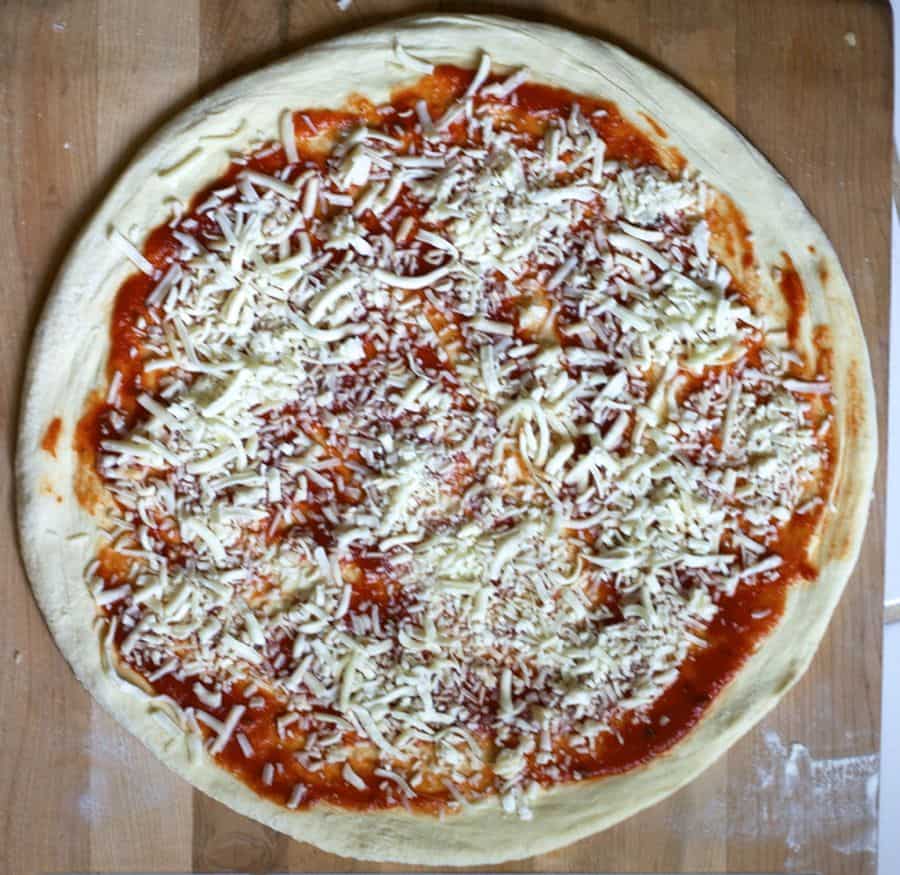
My Favorite Pizza Dough: The Big Secret (How You Proof the Dough)
My all-time favorite dough is NY style dough, which really is classic pizza dough that is stretched out into a thin crust pizza. This type of pizza dough contains water, flour, salt, instant yeast, and olive oil (and sugar especially when baking in a home oven, to help browning).
After it is mixed, it is proofed (left to rise/ferment) in the refrigerator for a minimum of 24 hours and up to 72 hours (it can also be frozen) – this is the big secret. I’ve used the dough up to 5 or 6 days afterwards, so you can essentially prepare dough for the week.
This recipe produces a crisp yet foldable crust that is tender, light, and flavorful and will make enough for four 14-inch pizzas. You can easily double or half the recipe to make 2 or 8 pizzas.

Fourteen Tips for Success
Tip 1: Choosing the flour
Use high-quality flour – I like to use King Arthur’s all purpose or bread flour; higher protein (ie, bread) flours work best. However, I prefer all-purpose flour because I like a lighter, airy crust.
Tip 2: Adding the yeast
Do not add instant dry yeast (IDY) directly to cold or cool water – you may shock the yeast (add the IDY to your flour instead) (please note that IDY differs from active dry yeast, which must be activated by adding it to water).
Tip 3: How much yeast?
Use only enough yeast to “get the job done” – yeast eats the sugar in your flour to produce its leavening effects – I find that if you use too much, your dough will be tasteless (this is just my opinion); however, it is a fact, that too much yeast can make your dough taste bad. Most recipes out there, some of them in well known, published books contain too much yeast!
Tip 4: Cold ferment that pizza dough!
Always use your refrigerator. The best NY style doughs “ferment” or “cure” in the refrigerator for at least 24 hours and up to 48 72 hours. This is called a “cold rise” (vs warm rise on your kitchen counter).
The refrigerator is used to retard (or slow) the dough’s fermentation, allowing that distinctive flavor to come through (ever wonder why some pizza crust tastes different than others, despite the fact that they are both made from just about the same exact ingredients? – this is a big reason why!)
When your dough rises too quickly, the flavor will not develop optimally. Slow rise = MUCH better flavor.
Tip 5: Weigh those ingredients!
Use a scale to weigh the flour instead of using a measuring cup – it is much more accurate and will yield superior results. I’ll admit, I resisted doing this for a loooong time. Just do it. You’ll be glad you did and your dough will be more consistent and much improved.
Tip 6: Add oil last
Mix the oil in as the last step, after the flour has all been incorporated. This is important to allow the flour to hydrate properly.
Tip 7: Flour your dough balls
Before tossing or opening your dough balls, flour them *very* well on each side (if you are a beginner) to ensure they do not stick to your counter or pizza peel. I sometimes use a bit more flour after I begin spreading them.
Tip 8: Keeping those rims a bit puffy
Take care not to “degas” the rim of your pizza as you are spreading your dough! Do NOT ever use a rolling pin! There are many different methods to spread/open your dough ball. I hope to add a few pictures someday of this process.
Tip 9: Baking pizza in a home oven
Ensure that your oven is preheated for a sufficient amount of time (about 1 hour) and bake the pizza within 6 to 8 inches of the top of your oven (ie, your broiler) so that the tops browns sufficiently in conjunction with the bottom of the pizza.
Do not place the stone near the bottom of your oven. I made this mistake for too many years.
After your stone has been preheated sufficiently, the heat from the stone will cook the pizza from the bottom and you can switch the broiler on if you find you need more browning on the top (I now use the broiler to bake my pizzas…more on this sometime in the future).
If you find that your cheese is browning well before your rim attains sufficient color, use partially frozen cheese (ie, place shredded cheese in the freezer while the oven is heating up) and cold sauce or you can drizzle just a bit of olive oil on top of cheese.
Tip 10: Use a pizza stone or steel
Use a pizza stone if you have one. The stone with draw moisture out of the dough and produce a beautifully crisp crust. I use a pizza steel because my stones kept breaking.
Tip 11: Use just the right amount of sauce
Do not use too much pizza sauce – it will make your pizza soggy
Tip 12: Find the right kind of cheese
Do not use low fat cheese to top your pizza or pre-shredded cheese (the former will not melt sufficiently and the latter contains additives that prevent the cheese from sticking together and therefore does not melt very well). The best is low-moisture, whole milk mozzarella.
If you must use pre-shredded cheese, I’ve found that adding the sauce on top of the cheese helps with the melting. Also, do not use too much cheese; apply it sparingly so that you can achieve that mottled NY pizza appearance.
Tip 13: Flour your pizza peel
Use semolina or flour on the bottom of your pizza peel to prevent the pizza dough from sticking but be careful not to overdo it because it will burn.
Tip 14: Learn to launch that pizza
Give the pizza peel a few very small quick jerks to make sure the pizza will easily slide off your pizza peel before attempting to transfer pizza to the oven, and more importantly, rub flour into the peel before placing the dough on top.
Essential Equipment
Please note that as an Amazon affiliate, we earn a small commission if you purchase a product at no additional cost to you.
I adore my baking steel; it’s transformed my home pizzas into restaurant-quality and better. You will love this! A kitchen scale streamlines measurement with remarkable accuracy, while a pizza peel is essential for smoothly sliding pizzas into the oven. And proofing boxes provide an optimal storage for pizza dough fermentation, enhancing flavor, texture, and elasticity.
Please visit our SHOP page for more recommended tools and equipment to make restaurant-style NY-style pizza at home!
How to Stretch the Pizza Dough
A nice video (from The GoodFellas Pizza School of NY), showing how to stretch the dough:

How to Freeze Homemade Pizza Dough
- After mixing dough and dividing into balls, place dough in refrigerator for at least 24 hours.
- Place dough balls on baking sheet lined with plastic wrap or parchment paper, cover loosely with plastic wrap and freeze until firm (~ 2 to 3 hours or up to overnight).
- Wrap frozen dough balls individually in plastic and store in zipper-lock bags for up to 4 weeks.
- When ready to bake, transfer unwrapped dough into the refrigerator for 12 to 24 hours before making pizza.
- Bring dough to room temperature for 20 to 60 minutes before baking (less time for hot kitchen/summer and more time for cool kitchen)
Pizza Dough Calculator
Need more dough? Less dough? Try out our new Pizza Dough Calculator to calculate the weights to get it just right!
Have More Questions?
Please See My NY Pizza FAQ
If you tried this recipe, please leave a 🌟 star rating and let me know how it went in the 📝 comments below! SUBSCRIBE for more recipes.
📖 Recipe

The Best New York Style Pizza Dough
Equipment
- pizza stone or pizza steel for baking
- Standing mixer optional or hand knead
- kitchen scale highly recommended instead of volume measures
Ingredients
Original Recipe for Four 14-Inch Pizzas; want to make more or less? Use the pizza dough calculator
- 6.5 cups (796 g) all purpose flour or bread flour (weighing is most accurate!)
- 2 1/4 cups (493 g) water barely cold water (17.4 oz per 2 1/4 cups)
- 1 teaspoon (3.5 g) instant dry yeast
- 2.5 teaspoons (15.6 g) salt
- 2 teaspoons (7.8 g) sugar
- 1 tablespoon (11.8 g) olive oil
1 Pound of Dough (~454 grams) (use the pizza dough calculator to make more or less dough)
- 2 1/4 cups (274.5 g) all purpose flour or bread flour
- 3/4 cup (170.2 g) water
- 1/2 teaspoon instant dry yeast
- 1 teaspoon salt
- 3/4 teaspoon sugar
- 1 teaspoon olive oil
Instructions
Mixing the Dough
- Place water in mixing bowl.
- In a separate bowl, mix salt and yeast (and sugar if using) into flour
- Combine flour/salt/yeast mixture into water and mix until all the flour has been incorporated.
- After flour has been totally incorporated, add oil and knead for about 4 to 5 minutes (see note)
- Test final dough temperature, which should ideally be between high 70s to low 80s (optional)
Dividing and Rising
- Divide dough into 4 equal pieces (using a digital scale if possible; each ball should weigh 11.5 oz [~326 grams]), shape into a ball, and place in greased, sealed quart-sized container or oiled/greased freezer bag and refrigerate overnight or up to 72 hours (After much experimenting, I have concluded that I like 3 days best but day 2 is good too).
Assembly and Baking
- The following day, remove your dough balls within 1 hour or less of baking and allow the dough to come to room temperature. (the dough will tend to blister more if the dough has not been allowed to come to room temperature however, I often bake coldish dough without problems, just some bubbling)
- In the meantime, place your pizza stone in oven and preheat at 550 degrees (depending on thickness of your stone and your oven’s power) for at least 1 hour
- Open each dough ball using care not to degas, transfer to a pre-floured pizza peel (or on parchment paper), and top with your favorite sauce, cheese, or other toppings.
- Transfer pizza from peel to oven or slide parchment paper onto preheated pizza pan/stone and bake for 4 to 6 minutes each until browned on top and cheese has melted but not burned.
- Enjoy!
Notes
- Use of weight based measurements is highly recommended instead of US Customary. You will need a kitchen scale.
- METRIC amounts DO NOT correspond exactly to the US Customary amounts because, for example, 796 grams equals 6.4 cups (and most can’t measure 0.4 cups or 0.22 cups). Recipe was based on grams.
- Use the Pizza Dough Calculator
- If you want to use the dough the next day, knead a little more (slow speed for about 8 to 10 minutes)
- If you have time to let the dough rest for 3 days, knead for 4 to 5 minutes, low speed or hand knead.
- After mixing dough and dividing into balls, place dough in refrigerator for at least 24 hours.
- Then, place on baking sheet lined with plastic wrap or parchment paper, cover loosely with plastic wrap and freeze until firm (~ 2 to 3 hours or up to overnight).
- Wrap frozen dough balls individually in plastic and store in zipper-lock bags to store for up to 4 weeks (longer may work, but results might vary).
- Before using, transfer unwrapped dough into the refrigerator for 12 to 24 hours before making pizza.
- Bring dough to room temperature for 20 to 60 minutes before baking (less time for hot kitchen/summer and more time for cool kitchen).
- calculate your own using baker’s percentages: 62% hydration, 0.4% yeast, 2% salt, 1.5% oil, and 1% sugar or use my new pizza dough calculator.
Nutrition
Try these other pizzas and this NY pizza sauce:
Buffalo style (one of my absolute favorites)
White with prosciutto
White with spinach and feta
Pizza sauce

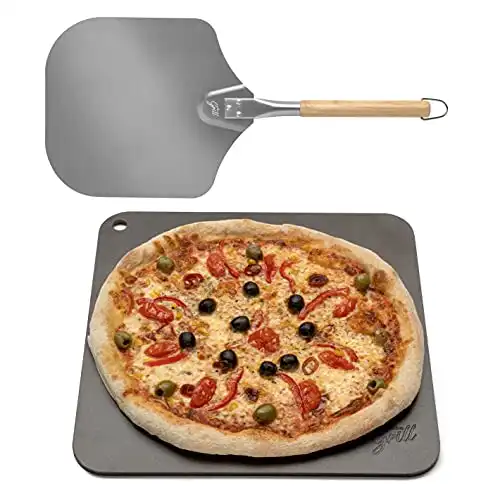
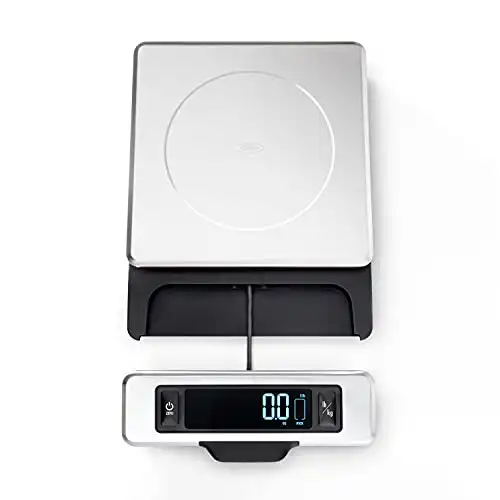
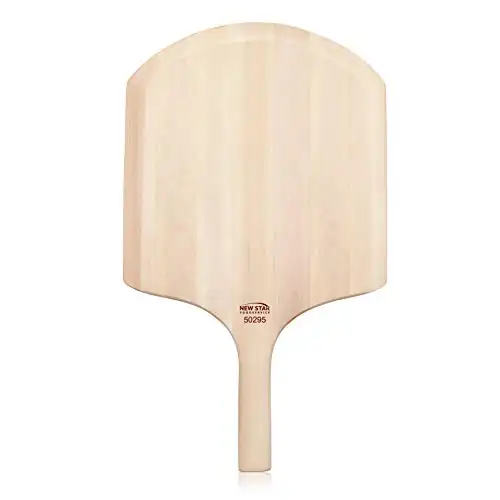
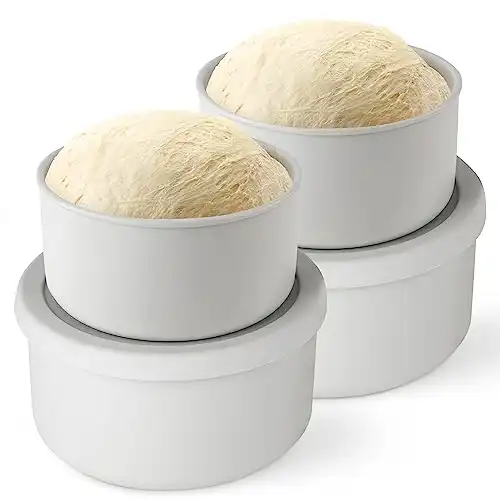
Marie-
Amazing recipe!!! Such science and attention to detail!
Answering almost all the comments? Girl, you deserve your own TV show. You are driven.
When are you opening a Pizzaria? I’ll eat there!!!
Some quick notes about yeast, sugar and salt. Active Dry Yeast, and most other forms, reanimate well in warm water. And yeast eats sugar, so if you reanimate it and have food waiting, it is happy.
Salt preserves. It freezes activity. Our ancestors have salted food for storage for thousands of years, even since before fire.
Salt puts yeast back into hibernation (which it is in with Active Dry Yeast and others before being taken out of the can.)
I assume that to add salt to the process, you would not want to add it in the beginning steps. Maybe to the flour when it is added? To dilute it? Or maybe when the oil is added, LATE in the process, long after the yeast is too strong to be killed, but right before the end to add flavor.
Thank you for the great feedback! All very helpful points!! I do hold back the salt when making my breads, but some bakers feel that using salt earlier in the process helps protect against over-oxidation caused by vigorous mechanical mixing and it also tightens up the gluten network. And the brand of active dry yeast that I use doesn’t require re-hydration (Red Star) although you can as you describe. Now, this is the first time I read this but according to this link (http://redstaryeast.com/yeast-baking-lessons/yeast-types-usage/active-dry-yeast/) bullet 8, sugar coming into direct contact with yeast is not good. I’ve never read that one before and so I’m perplexed! I’ve always read that it “feeds” the yeast just as you stated….hmmm. maybe a typo?
I have been trying to make pizza for about 8 years now and this is by far the best recipe I have used. I have been using this one for the past dozen or so pizzas and my family and I love it. I add a little garlic to the dough to change it up sometimes, and make 3 pizzas rather than 4. I wait 24 hours for the first pizza and freeze the rest of the dough for later. I usually make 3 pizzas a month. My family and I thank you for the recipe!
Glad to hear this, Ed! I love that it’s pretty fast (hands on time that is) – love the idea of adding garlic seasoning. Yum!
Thank you so much for this great website. I’ve made the dough at least 3 times now. It is excellent! We usually crave pizza right away so I make half the recipe, use one dough that day and save the second for 2 days later. Both always turn out delicious!
Hi Marie….you say “mix” the flour yeast water etc……but there is nothing about kneading? How long should it be kneaded? and why dony you mix the yeast and sugar wiyj warm water first to make the yeast start working? thank you, Bob
Hi Bob – the yeast I use doesn’t require “activation” with water or sugar and so I don’t usually do that. However, I encourage you to follow the directions on your brand of yeast. I use Red Star or SAF, both don’t require that step (even the active dry yeast). Regarding kneading, yes, definitely – see step 4 in instructions, which state to begin kneading after you add oil. Hope this helps!
Great recipe. My only issue was that the dough was very springy and difficult to press out by hand. Any idea what I might have done wrong?
Thanks!
It sounds like maybe the gluten wasn’t developed enough…perhaps try kneading the dough a little longer and see if that helps. It also helps to stretch the dough, let it relax a little and then finish stretching
Hi… I have made this recipe several times and it is always good… usually I just leave in the fridge about 24+ hours then use it. I do want to try freezing sometime, because we usually do not need 4 pizzas LOL
I wanted to mention that if anyone likes to grill pizza, I have had several successful cooks using this dough, a pizza stone or pan are useful on the grill.
I haven’t tried grilling the dough in a while – sounds like a great idea! I guess one of the tricks is somehow getting the stone a few inches off the grill, at least for me it is. I would use an inverted rectangular metal pan and then place the pizza steel or stone on top of that but I’m sure there are other methods too
Hi again,
Thanks so much for your advice regarding my dilemma with fermenting dough in bulk. However now I have another question, I want to prep the dough and build the pizza..sauce it, add toppings and cheese and store it in the fridge for tomorrow’s party. Can I prep pizza a day in advance? Once again my dough is fermenting in the fridge now for two days….so how can I go about prepping the pizza for a party the next day?
Much appreciated!
Rose
Hi Rose – I definitely would not sauce it etc in advance. Once the sauce is on the raw dough, it will begin to absorb the water from the sauce and so the aim is to get it into the oven as soon as possible. Maybe precooking the pizza a little bit might do the trick but I’ve never done this so I’m afraid I can’t give you much advice.
The best thing to put on the peel before putting the dough on is farina. If you don’t know what this is, look on the bottom of an english muffin. It does not burn easily and provides more slide action.
Awesome recipe! Quick question, how bad
is it if I forgot to portion the doughs separately and instead just put the whole dough in one bag….? I’m afraid I have to start over since I didn’t portion and separate the doughs when placing in the fridge to rise?
Your thoughts appreciates,
Thanks!
No worries, Rose. Some people prefer to bulk ferment like you did. When you are ready to bake, divide the dough, shape into balls, and let it rest for about an hour or so. Good luck!
Hi there, I’ve been dying to try this recipe for a few months now and finally got around to making it tonight. I just had one question so far.. I used King Arthur AP and a scale to weigh everything very accurately to within .1 gram and my dough is quite sticky.. I weighed out the final product and I definitely got your 11.5ish oz per section so I’m quite sure I got the ratios right.. The dough doesn’t hold it’s shape but it’s not soupy or anything like tat.. It just flattens out a bit when I put it into the bags and it was sticking to my hands pretty severely…. I’m just wondering if this is what should be going on with this particular recipe or if I just needed to add a bit more flour? We’re going to do 2 of them tomorrow at 24 hours and then the other 2 at 72 to hours to compare the difference.. I appreciate your attention to detail and just wanted to get some confirmation on the stickiness level I should be experiencing if possible..
Thanks very much!
Hi Rob – I’m sorry I missed this question. I would have probably just added a little flour to the outside of the dough balls. How did it work out?
Hi Marie, thank you very much for this recipe – I tried it out and it was amazing!
I was wondering if you might please tell me what amount of this recipe I should use for making one 18 inch pizza?
Also, I have no idea what the right amount of cheese and sauce is recommended for an 18 inch pie?
Thanks!
Hi Alejandro – Yes, if you look in the NY Pizza FAQ tab , review question number 1 and you can learn to calculate the amount of dough for any size pizza you would like to make. For the sauce and cheese, I usually just estimate it. I’m sorry I don’t have weight measures for you but if you look at the post for ny pizza, you can get an idea of how much sauce and cheese to use and then adjust to your taste. Too much sauce might cause your crust to be soggy and too little cheese may end up burning before the pizza is done. Hope this helps
Thank you very much! Another doubt… Have you ever mixed this recipe (or any other) using a professional ground dough mixer? Do you throw in all the ingredients in the same order that your recipe dictates all at once into the mixer or do you do it in a bowl and by hand first and then throw it in? Thanks!
Has anyone tried this using the Pizza Dough setting of a Bread Machine? Thank you,
Hi Christine – I personally have zero experience with a bread machine, but you can read about it here: https://www.pizzamaking.com/forum/index.php?topic=29002.0
Exceptional dough … GREAT instructions! I’m making this now for the second time. First go ’round yielded a very dense dough. I couldda brained my neighbors cat with it (not that I’d ever do such a thing). I kept adding water until it softened up a smidge. My scale was crappy – which is how I ended up with too much flour – so I bought a fir-real kitchen scale so that oughtta take care of that little issue. The crust tasted FAB even with my shoddy chefsman-ship! So I’m EXTRA excited to give it a go again!
THANKS FOR POSTING! I bow to your dough making prowess!
Best dough ever!! I’ve been looking for a thin crust forever and now the search is over. I was using too much yeast and had never tried a slow, cold rise in the fridge. Not only did the crust turn out perfectly thin but it tasted so good! I weighed all my ingredients just like you suggested and I used a perforated, steel tray. I also used Active Dry Yeast and didn’t have any problems. I can’t wait to make it again (and neither can my kids!). Thanks so much Marie!
I just baked the firts one and it is totally fab!!!
Came out a little more crisp than intended – but all down to me experimenting with my oven as I don’t have a stone or pizza steel, so I used the wide tray the oven comes with. Also my oven can only do 482 F (250 °C) so left it some minutes longer to make sure the dough has the colour it should.
I am just about to put the second batch in and will take more care of the time – I’m convinced it will just be perfection.
I’ve only ever been to NY once and had the chance to sample NY pizza that one time (at probably not the best either as I just grabbed the first one that came into sight) but when I took that first bite… my oh my! Angels sung and heavens parted. I grew up watching Friends eating that wonderful stuff and my mouth kept watering. Being an enthusiast for years I’ve been searching… Marie, I can’t thank you enough – THE SEARCH IS NOW OVER!!!